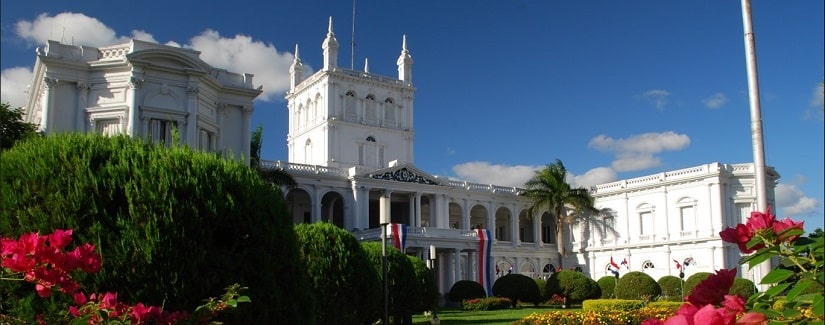Paraguay has a very young population—half of its more than 7.5 million inhabitants are under 27 years old—and its economy is based on agriculture and livestock. The main trading partners of this Latin American country are in the region: Brazil and Argentina.
Geographical and meteorological conditions make Paraguay a very sparsely populated territory: in addition to its extreme climate, with average year-round temperatures exceeding 68°F, its capital, Asunción, has no established international connections. The main connections are made by road and especially in the direction of its two main trading partners: Brazil and Argentina, for which there are daily bus departures and arrivals.
Leader in Clean Energy Production
Although it has so far received low marks in this area from institutions such as the World Economic Forum, Paraguay is currently immersed in a Comprehensive Infrastructure Plan. This includes an ambitious program on the transition toward electric mobility described as “an unprecedented effort in the nation, the result of participatory workshops with the presence of high-level and technical specialists from key agencies for the design, feedback, and validation of the contents that now represent the commitments to be met.” Paraguay’s Ministry of the Environment and Sustainable Development stated that this plan contemplates the replacement of 100% of the public transportation fleet of buses and 50% of taxis, as well as the addition of electric bicycles in the country’s five main cities, among other areas.
Although we are talking about a small country, Paraguay stands out for being the largest per capita producer of clean energy in the world: all electricity demand is covered by renewable and local sources, originating at the Acaray, Itaipú, and Yacyretá hydroelectric power plants.
Promoting Trade Within the Region
Last fiscal year, the distribution of GDP by sector in the region shows greater representation of the tertiary sector (49.6%), although the weight of the economy is supported by the primary sector, especially agriculture and the economy, Paraguay’s economic engine, which is responsible for 21.6% of the active population.
For almost 40 years, the region has applied trade liberalization, with exceptions for health and safety reasons, which has boosted the import of goods and the dissipation of a local substitute industry at any cost. Its profile is therefore geared toward the export of commodities and the import of manufactured products, as indicated in the latest report on the region published by ICEX. Paraguay’s main trade partners are Brazil and Argentina, closely followed by Chile, with a significant impact.

Among Latin American countries, Paraguay has the lowest level of Foreign Direct Investment (mainly due to its small market size), but according to data from the Economic Commission for Latin America and the Caribbean (ECLAC), in 2022 it exceeded that of the previous fiscal year (129%) and earned $474 million. According to the organization’s report, “most of the inflows corresponded to reinvested profits (64% of the total), which were 61% higher than in 2021.” Intercompany loans, meanwhile, rebounded after a significant drop in 2021, but accounted for only 3% of the total DI received in 2022.
With regard to the External Debt acquired by the country, the Ministry of Finance highlights “the low level that constitutes one of the strengths of public finances,” as Paraguay has one of the lowest volumes in the region, below the average of countries with the same credit rating. The latest official report from the Ministry, corresponding to October 2023, shows a slight increase compared to the same period of the previous year, when it was 32.1% of GDP, to the current 32.9% ($14.4845 billion).
A Discreet Trade Network
The business community is primarily concentrated in Asunción. Only the fertilizer and agricultural supplies sectors reach the department of Alto Paraná. ICEX also highlights a second market formed by neighboring countries, especially Argentina and Brazil, whose citizens enter Paraguay to take part in “export tourism,” whereby they benefit from a regime that allows them to purchase products imported from the country in cities on Paraguay’s border. This second line of trade is a result of the advantage of the lower duty rate these products have in comparison with the one unified by the Southern Common Market based on an exception granted to the country for a limited time, as its duties were lower before joining Mercosur.
Trade activity is concentrated in a small number of intermediaries with the capacity to control the entire network in which, in many cases, the same firm acts as importer, wholesaler, representative, and distributor. This situation limits the ability of operators to specialize.
Nevertheless, the country still has a lot of potential to explore. Prior to the COVID-19 pandemic, Paraguay had been experiencing stable economic growth, with only two contractions in GDP over 15 years (in 2009 and 2012). Although the lockdown caused a pause in this evolution, in 2021 the region’s activity began to rebound, with GDP growth of 4%. Although contextual aspects such as a severe drought and the war in Ukraine were a setback for the region, which only grew by 0.1% in 2022, development expectations for 2023 exceed those achieved last fiscal year.
As business opportunities, ICEX highlights the agriculture sector (machinery and fertilizers), construction materials, electrical equipment, water treatment equipment, and the pulp and paper industry, among others. “Unlike other countries with similar needs, Paraguay is in a better relative position in that it can access international sources of credit on favorable terms, given the low relative level of debt to GDP,” it concludes.




